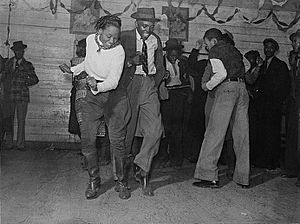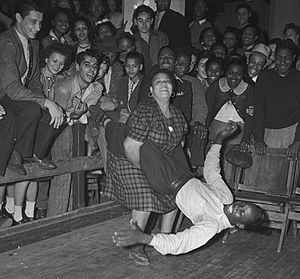Jitterbug facts for kids

Jitterbugging at a juke joint, 1939. Photo by Marion Post Wolcott
|
|
| Genre | Swing |
|---|---|
Jitterbug is a fun and energetic dance style. It is a general name for many types of swing dancing. You might hear it used to describe the lindy hop. It can also include moves from jive, east coast swing, collegiate shag, charleston, and balboa.
Swing dancing began in the early 1900s. It started in African-American communities in New York City. Back then, many clubs had rules about who could dance together. This was due to racial segregation. But the Savoy Ballroom in Harlem was different. It allowed everyone to dance together. Here, the lindy hop dance became very popular. Dancers like George Snowden and Frank Manning helped it grow.
The word "jitterbug" first described white dancers. They danced the lindy hop faster and jumpier. It was like "jittering bugs." But the name soon became popular. Both the lindy hop and "jitterbug" spread. They became famous outside Harlem. This happened when they appeared in Hollywood movies and Broadway theatre. The dance group Whitey's Lindy Hoppers helped a lot.
Contents
What Does "Jitterbug" Mean?

The word "jitterbug" comes from two words: "jitter" and "bug." The Oxford English Dictionary (OED) explains this.
The word "jitters" first appeared in 1929. It meant feeling nervous or shaky. For example, someone might say, "Willie's got the jitters."
The term "jitter bug" was first used in a song. This was the 1934 song "Jitter Bug" by Cab Calloway. The lyrics mentioned "four little jitter bugs." It also said, "He has the jitters ev'ry morn."
Later, the word "jitterbug" described a person. It meant someone who loved swing music. It also described someone who danced to swing music. This dancing was often very lively and athletic.
How the Jitterbug Dance Started
Jitterbug dancing grew from other dances. These dances were done by African-Americans. They danced at juke joints and dance halls. The Carolina shag and single Lindy Hop were important. They formed the base of the jitterbug. When rock and roll music became popular, the double Lindy Hop also grew.
White dancers learned the energetic jitterbug. They watched dancers at black venues. Places like the Hill District in Pittsburgh were popular. The Savoy Ballroom in Harlem was also famous. It was a place where both black locals and white tourists danced. Norma Miller, a Lindy Hop dancer, performed there. She said that many dances were planned beforehand. Tourists sometimes thought the dancers were just dancing socially.
A song called "The Jitterbug" was written for a movie. This was for The Wizard of Oz in 1939. In the story, a "jitterbug" was an insect. The Wicked Witch of the West sent it. This bug made the heroes dance in a jitterbug style. The dance scene was not in the final movie. But the song was released on a record.
Jitterbug's Rise to Fame
During World War II, the jitterbug spread. American troops helped carry the dance overseas. About 2 million American soldiers were in Britain by 1944. Before the war, dancing was not very popular in Britain. Many dance halls were closed. But when American troops arrived, many halls reopened. They often used jukeboxes instead of live bands.
Many working-class women started dancing. They danced with American soldiers and sailors. The jitterbug became very popular. By 1945, American troops in France were jitterbugging. By 1946, it was a craze in England. It was even a competition dance in Australia.
In 1945, a dancer named Florida Edwards was hurt. She was jitterbugging at the Hollywood Canteen. A court awarded her money for her injuries. This shows how active and popular the dance was.
In 1957, a TV show called American Bandstand became national. It showed popular songs and live musicians. People danced in the studio. At this time, jitterbug was the most popular fast dance. It was a very lively dance from the swing era.
In 1962, a musician named Bill Black talked about dances. He had played bass for Elvis Presley. He said "jitterbug" was one of the few dances you could play music for. He listed it with the twist and cha-cha.
See also
 In Spanish: Jitterbug para niños
In Spanish: Jitterbug para niños
- Balboa
- Lindy Hop
- Shag
- Big Apple
- Charleston (dance)


